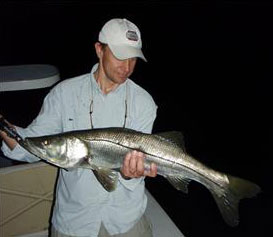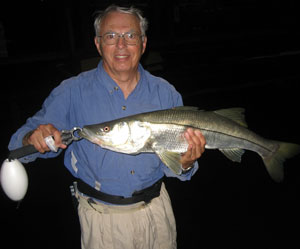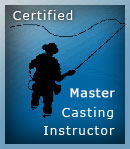Flies and Snook Under the Lights
As long as the water temperature remains above seventy degrees, it is now 84 where I fish; dock snook will readily take a well presented fly. Docks close to the passes are loading up with transition fish. The Tampa bay has a good snook population and the recent changes in regulations will only make large snook more available. Good fly rodding for linesiders is best when you can find a concentration of fish. Lights and their attraction for plankton, which in turn attracts bait fish, is a dinner bell for lazy predators. “Matching the hatch,” has been most productive for me. The size of the fish they are pursuing is easy to determine by watching the frantic bait scatter when Mr. Snook makes his run. Select a fly that closely duplicates his forage and success is guaranteed.

Most of my fishing is from a Hewes Redfisher, equipped with a bow mounted Minn Kota. Not using an anchor, allows me to maneuver the boat away from the dock and structure quickly after setting the hook. Two experienced fly fisherman can fish at the same time and help one another when one is hooked. This is not a problem with small fish, but in the area I fish most fish are over 24 inches and every outing results in a few broken leaders as Hawgs head for the pilings.
Tackle requirements will vary with the size fish that will be encountered. A few years ago I spent a week in Naples and fished dock lights every night. I caught very few fish over 23-24 inches and used a 9 foot, 7 weight, with a floating weight forward line, most of the time. A 9 foot leader with a 20 pound shocker was more than adequate. Here I use a 9 or 10 weight, one with a floating and one with a sink tip weight forward line. 30 to 40 pound fluorocarbon shock tippets are used. If you want to use regular mono, I suggest Mason because of its stiffness and abrasive resistance. The extra investment in fluorocarbon for a shock tippet is well worth it.
Check the tide charts and pick a night or early morning when you have maximum tidal flow. This is very important! If you don’t have moving water, they will not be active. If a fast flow is just beginning, a feeding frenzy could be your reward. As you approach a dock, if you see fish actively chasing bait, you know you’re going to have a bonanza.

Fly patterns that match the bait they are chasing will get results. I’ve thrown larger flies that look irresistible, but are refused. Ninety percent of the time a minnow imitation is used, occasionally a small shrimp pattern is preferred. The fly that was a hot item the last time out will not work tonight. Accurate casting is needed; a sloppy presentation will spook fish. If one or two snook are caught under one light, even thought there are other fish present, a move to another area to let the fish settle will get them feeding again. I often fish an area where enough lights are present that only my electric is needed to move around. When using the electric, a constant, slow steady speed will not spook fish like frequent starting and stopping.
Night fishing makes normal function more difficult. Get very familiar with everything in your boat. Organize your fishing so that you can find what is needed without fumbling around and making noise. Remember, you are usually in someone’s back yard. If there’s a big noisy dog in the neighborhood, he’ll be out on the dock letting everyone know you’re there. Decorating a dock with flies and leaders is not the way to get an invitation back. Be courtesy and quiet! If someone is on a lighted dock, I use my electric to get close and let them know how much I appreciate being able to fish there. You will be surprised at their reaction, and will often get more good information. Recently a dock owner said to me, “you should try Ted’s dock over there, he has a lot of structure in front of his place.”
Night fishing for snook around lighted docks is one of my favorite fly fishing pursuits. Give it a try, and see what you’ve been missing. The first time a big, mean snook grabs your fly and heads for the barnacles you will begin to adjust you’re your sleeping pattern to allow more time for unbelievable excitement.
![]()



